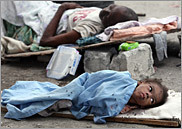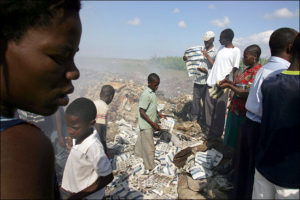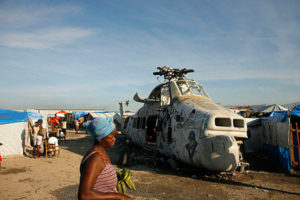Editor’s Note: This series from John Ripton provides a continuing look at the Mano a Mano medical team and the people and conditions its members encounter in Port-au-Prince, Haiti, from Aug. 7 to 14. John Ripton, a Lebanon Township resident, is a board member with Mano a Mano, an international relief organization based in Roselle Park. He holds a doctorate in Latin American history, is a history chairperson at Gill St. Bernard’s School, and is an adjunct professor at Rutgers. Ripton also has published articles, essays and poetry in various magazines and journals.
Canaan camp is one hour north of the raucous, ragged streets of Port-au-Prince. Canaan is a broad agricultural valley where cattle graze in marshy fields and bananas thrive. To the north semi-arid hills flank the fertile valley. Beyond is the first wave of denuded, scarred mountains. The government of Haiti declared a swath of the hills public lands in the wake of January’s earthquake. Talk of resettlement, even decentralization, of the urban population of Porto-au-Prince quickly circulated. Poor people, victims of the earthquake and others, migrated toward this stretch of dry hilly land.
As the Canaan camp came into view, members of Mano a Mano’s medical team are stunned. Flaps of nylon and plastic stir in withering gusts of wind. Frames of cut poles lashed together wait for makeshift walls and roofs. No one seems to be living here. Distant silhouettes of people eventually emerge from this surreal, haunting landscape. At first glance, the place resembles an abandoned refugee camp just across the border from a zone of conflict in a neighboring country.
When the team pulls into the camp’s center it is greeted by the leadership of the “community.” Soon a nylon tarpaulin is stretched as a canopy for the “pharmacy.” The tent-like dwellings are just too hot to be in during most of the day. So the registration of patients is conducted in a wooden structure with only two walls. It stands twenty yards up a slope from the pharmacy. Twenty yards on the other side of the pharmacy, up another slope, the physicians examining rooms are a series of rood stalls with a dilapidated roof. Someone from the camp ranges throughout the hundreds of similar structures strewn across nearly a mile of hills to let residents know that the doctors have arrived.
The team discovers similar conditions to those it observed in the ghetto of Belle Aire in its first two days in Haiti: skin and eye irritations, hypertension, ring worms, vaginal infections, post-traumatic stress disorder, and more. In a discussion with one mother of a child who was carried to see a physician it is determined that he contracted typhoid fever when he was an infant. Tragically the child was not treated and the disease left him unable to walk or stand on his own. There is nothing that the team can do for this young adolescent. The physician promises him a soccer ball. As the medical team packed its pick-up and van in the late afternoon, the boy crawls up the hill to the physician to receive his gift. A broad, deep smile carves his upturned face.
Ifieis Joseph Joel, a member of the medical team who lives in Union, New Jersey, holds back tears welling in his eyes as the young disfigured boy moves on this hands and feet on the stony ground. He appears to be a slow crab. The boy has one eye that opens only partially. His mother has four other children. There doesn’t seem to be a father at home. “I am heart-broken to see this. This is desperate, desperate, desperate!” he says, deeply wounded by what he sees in the country in which he was born and left in 1991. “Why doesn’t the Haitian government bring water and food to these people? You can’t live without adequate water.” His question seems partly rhetorical. Joseph seems to know the answer before he utters the question.
Water arrives at Canaan camp periodically. It is trucked in, stored, and distributed among the residents. Everyone seems perpetually thirsty, always signaling to their stomachs, begging for water and food. Hundreds of dwellings are scattered across these hills. The president of the community says about 450 people are presently in the camp. Some camp residents have gone to nearby towns and intersections along the region’s roads where they may be lucky to beg or perhaps run errands for a pittance. Many women and children can be found in the camp day and night. Sometimes men will leave the camp for a few days to return to Porto-au-Prince or another city from which they migrated. They may have a scrap of a dwelling there or family with whom they can stay, closer to the possibility of meager food and what little money that might be made in street commerce.
Joseph Joel continues his reflections about the extreme desolation of this camp. Growing up in Porto-au-Prince, his father was in the Haitian National Guard. Now living in Union and working as a cardiac technician at Trinitas Hospital in Elizabeth, Joseph’s church (Mount Olive Church in Orange, NJ) has sent congregational groups to Haiti since 1999. He is profoundly dedicated to the welfare of his native land. He works relentlessly in the temporary clinics Mano a Mano establishes each day. It clearly pains him to see so many women and children with vaginal infections from living in the filth left to his desperately poor countrymen.
Parked near the medical team’s improvised pharmacy is a pick-up owned by a pastor of an evangelical church. Religious messages are printed on wooden planks forming a canopy and roof over the pick-up body. It remains there throughout the day, a few young men gathered near it talking. Wilgens Milius, an assistant to Pastor Casimir, says the church is located in Port-au-Prince and he and Pastor Casimir, visit the Canaan camp often. He explains that the church is part of the Church of Christ in the United States. Wilgens and Pastor Casimir are evangelists who hope to “improve the lives of the camp’s residents.” They have initiatives in other camps as well, hoping to build churches and schools. These two well-dressed religious leaders speak English. They are one of the first people to greet the medical team members. They continue to approach the team, trying to engage members in conversation throughout the day.
At the close of the day Pedro Gonzalez and Father Romano discuss the camp’s future. Dr. Cordero says it is unclear to him how the camp was started, how the leadership was determined, who has rights to the land. “Is this a temporary shelter for these people until other plans are formulated? The lack of water, food, services encountered out here are the daily challenges to the life here.” He grows more impatient in his voice: “If the government is serious about relocating people outside of Porto-au-Prince, there should be avenues for these people to actually acquire title to these lands in the future. These people just languish here. Will they been thrown off the land in the future?”
Father Romano says this is a political positioning undertaken spontaneously by poor people because they believe this public land will eventually be given to the settlers. They count on international organizations that focus attention in the camps to provide some basic amenities such as drilled wells and water pumps or construction of a school to strengthen their claims to this land. They do not expect the government to do anything for them. It never has. But the flood of private and public assistance from abroad brings a new political dynamic and new opportunities for poor people to stake their claims to an improved life, perhaps a permanent home or a school for their children.
Since there is no control of the settling of public lands, Father Roman fears that the Canaan camp may become another Cite Soleil, the largest slum in Porto-au-Prince. “Huts can spring up anywhere. People build unsafe places to live without any standards. It is unsafe, crime-ridden, filled with refuse. Tidal rivers are so filled with household waste and debris that in the low tide you can walk across tons of refuse that literally saturate the riverbed up to its banks. This place can become like that.” If one comes back to Canaan camp in the fall, he confidently predicts, the entire area will be overcrowded with many more poor people trying to obtain any opportunity the camp may offer to them to feed and educate their children.
The leaders of Canaan camp, Mano a Mano and Maryknoll coordinator Father Roman have varying realities and agendas in their minds as they discuss the possibilities of collaborating on behalf of the camp’s desperate residents. The settlers need a water pump. They need a school. Mano a Mano and Father Roman want to help. They discuss how they might accomplish this. But there are no promises. The leaders, whose personal agendas are both evident and murky, also must negotiate their way with Mano a Mano and the Maryknolls. It is a tenuous situation. Hope is one thing; drilling for water and building a school are another. The cards are stacked against the Canaan camp settlers. But it is also clear that Dr. Cordero and Father Roman are determined to do whatever they can to acquire the funding and enable the community to make these basic improvements.
After supper good news is announced. A vice-president at Beth Israel Hospital in Newark, New Jersey has agreed to arrange surgery for the young man with heart failure the team had reluctantly left behind in St. Martin. Everyone applauds. Now they need to secure passage to the United States for the young man. Dr. Cordero and Father Roman St. Vil are fairly confident it can be worked out.
John Ripton


